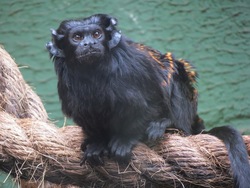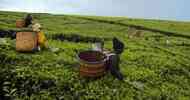
Black-handed tamarins (Saguinus niger) were one of just two primate species encountered in oil palm plantations, though they never strayed more than 300 meters from the forest’s edge. Photo via Wikimedia Commons, licensed under CC BY-SA 3.0.
Oil palm plantations in Amazonia inhospitable to tropical forest biodiversity: Study
According to a study published in the journal PloS One late last year, the Brazilian Amazon has about 2.3 million square kilometers (nearly 900,000 square miles) of land suitable for oil palm cultivation, making it one of the largest areas in the world for potential expansion of the palm oil industry.
Researchers investigated the responses of tropical forest mammals to living in a landscape made up of a mosaic of 39,000 hectares (more than 96,000 acres) of mature oil palm plantations and 64,000 hectares (a little over 158,000 acres) of primary Eastern Amazon forest patches in the Brazilian state of Pará.
They write in the study that their results in the Amazon “clearly” reinforce “the notion that oil palm plantations can be extremely hostile to native tropical forest biodiversity, as has been shown in more traditional oil palm countries in South-East Asia, such as Malaysia and Indonesia.”
According to a study published in the journal PloS One late last year, the Brazilian Amazon has about 2.3 million square kilometers (nearly 900,000 square miles) of land suitable for oil palm cultivation, making it one of the largest areas in the world for potential expansion of the palm oil industry. That, coupled with the fact that the Brazilian government is encouraging oil palm expansion as a major new opportunity for socioeconomic development, has led to speculation that the Amazon could become one of the largest oil palm-producing regions in the world within just a few decades.
Ana Cristina Mendes-Oliveira of Brazil’s Federal University of Pará and Carlos Peres of the UK’s University of East Anglia led the research team behind the PloS One study. They investigated the responses of tropical forest mammals to living in a landscape made up of a mosaic of 39,000 hectares (more than 96,000 acres) of mature oil palm plantations and 64,000 hectares (a little over 158,000 acres) of primary Eastern Amazon forest patches in the Brazilian state of Pará.
In the study, Mendes-Oliveira, Peres, and co-authors write that their results in the Amazon “clearly” reinforce “the notion that oil palm plantations can be extremely hostile to native tropical forest biodiversity, as has been shown in more traditional oil palm countries in South-East Asia, such as Malaysia and Indonesia.”
The authors note that there has been little attempt to understand the impacts on Amazonian mammals of converting primary and secondary forests into oil palm plantations despite the fact that the areas most likely to be converted to oil palm plantations overlap with areas harboring numerous threatened species of birds and mammals. So they set out to investigate how medium-sized and large-bodied terrestrial and arboreal mammals respond to an Eastern Amazonian landscape mosaic that includes oil palm plantations and large remnants of primary forest.
“These mammal taxa account for a disproportionate amount of the overall vertebrate biomass in Amazonian forests,” they add. “So any adverse effects to these species could amount to profound repercussions to ecosystem functioning across entire landscape mosaics.”
The region of Eastern Amazonia in which the researchers conducted the study has a history of deforestation going back to the 1970s. Over the decades, the forests in the area were mainly subjected to conventional timber extraction and converted to pastureland for cattle, but in recent years the Brazilian government has begun subsidizing forest conversion for oil palm plantations. Today, the remaining forest patches are interspersed with plantations ranging in size from 1,500 to 15,000 hectares (3,700 to 37,000 acres).
Using both traditional line-transect survey methods as well as camera traps, the researchers logged 1,059 sightings of 36 medium-sized and large-bodied terrestrial mammal species during the study period. They recorded a total of 32 species in primary forests, and 23 species in oil palm plantations. “Considering data from both survey techniques, overall species richness and abundance were [significantly] higher in primary forest compared to oil palm monoculture,” the researchers write.
Even the mammals that the researchers did find in oil palm plantations weren’t likely to stray far from the forest: 20 of the 23 species recorded inside of a plantation were never encountered any farther than 1300 meters (about 0.8 miles) from the forest’s edge. Mendes-Oliveira, Peres, and team found that only three species could be described as “thriving” in oil palm monoculture, while “all other species may use oil palm patches in their immediate forest neighborhood, but would likely be extirpated in the complete absence of primary forest within the wider landscape mosaic.”
Certain traits seemed to determine which species were capable of adapting to oil palm monoculture. Species that are habitat generalists who range widely across open areas, like the crab-eating fox (Cerdocyon thous) and other terrestrial carnivores, were found to be most tolerant of oil palm plantations. In fact, the researchers write that the crab-eating fox is “the only species that we can categorically interpret as clearly favored by oil palm plantations… This Brazilian Cerrado species specializes in open habitat areas, and has expanded its range and vastly increased its overall abundance throughout many anthropogenically disturbed parts of the Amazon.”
On the other hand, arboreal and terrestrial forest specialists, such as primates and sloths, were found to be largely intolerant of oil palm plantations. Of the primate species recorded by the researchers, for instance, only black-handed tamarins (Saguinus niger) and brown capuchin monkeys (Sapajus apella) were observed in oil palm patches, and they were never discovered more than 300 meters from primary forest. The researchers also identified at least three mammal species that are classified as Vulnerable by the IUCN Red List that were never recorded in oil palm plantations — the Giant Armadillo (Priodontes maximus), the Giant Anteater (Myrmecophaga tridactyla), and the White-lipped Peccary (Tayassu pecari) — while two Critically Endangered primates — the Ka’apor Capuchin (Cebus kaapori) and the Black Bearded Saki (Chiropotes satanas) — were found to rarely use plantations.
Given the prospect of large-scale expansion of oil palm operations in the Brazilian Amazonia in the near future, the researchers suggest that retaining large areas of primary forest within the plantation matrix is the only way to protect these threatened species.
“Most of the Amazon is perfectly suitable for oil palm monoculture, which is rapidly becoming a highly lucrative land use,” study author Carlos Peres said in a statement. “We have to make sure we strike the right balance between setting aside enough forest habitat for all native biodiversity and agricultural frontier expansion of rather sterile biofuel croplands, such as oil palm.”
Peres and co-authors provided a much more blunt prognosis within the study: “Our results paint a pessimistic scenario considering the extremely high suitability of most Amazonian soils and climatic conditions for oil palm monoculture and the rapidly growing demand for biofuels and vegetable oils around the world.”
CITATION
• Mendes-Oliveira, A. C., Peres, C. A., Maués, P. C. R. D. A., Oliveira, G. L., Mineiro, I. G., de Maria, S. L. S., & Lima, R. C. (2017). Oil palm monoculture induces drastic erosion of an Amazonian forest mammal fauna. PloS one, 12(11), e0187650. doi:10.1371/journal.pone.0187650













